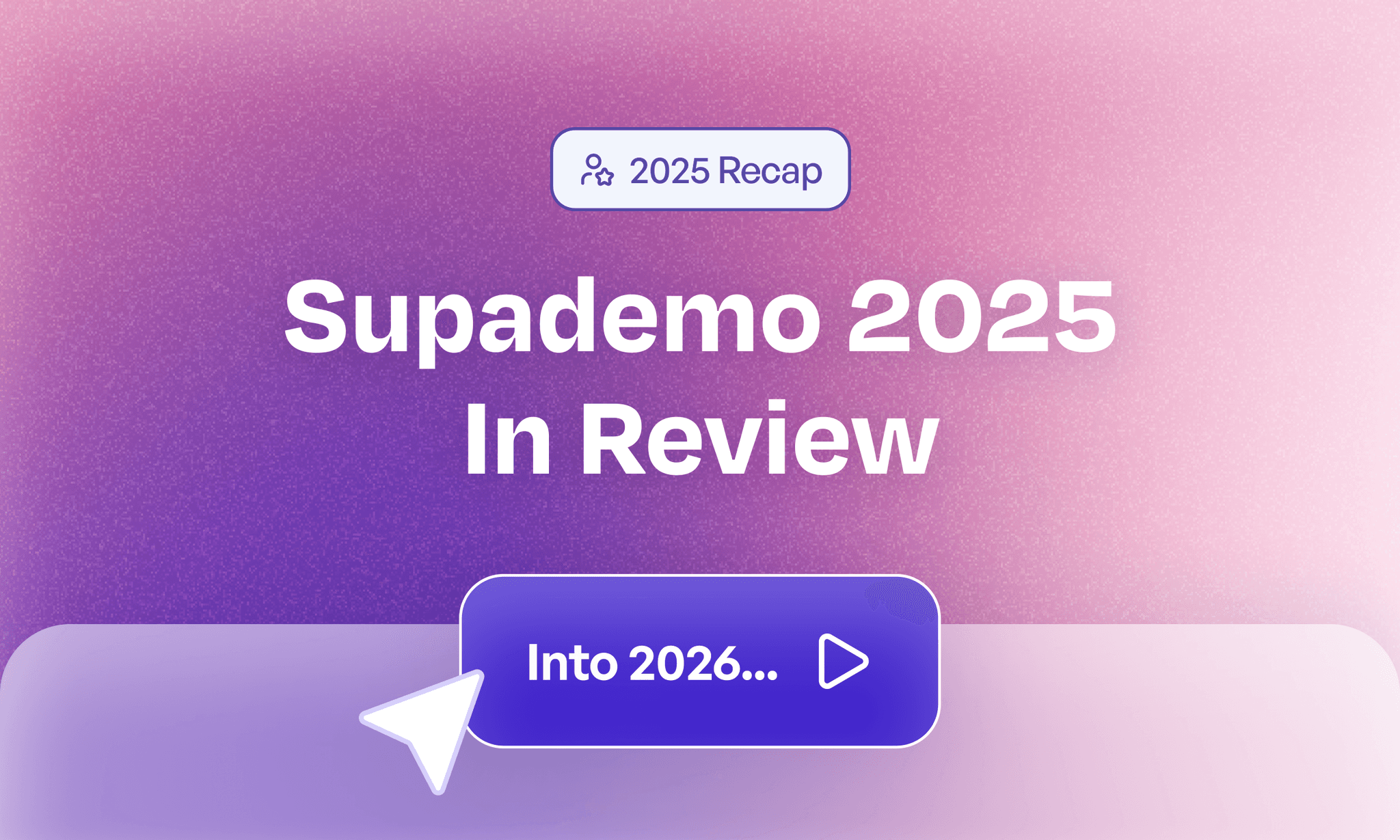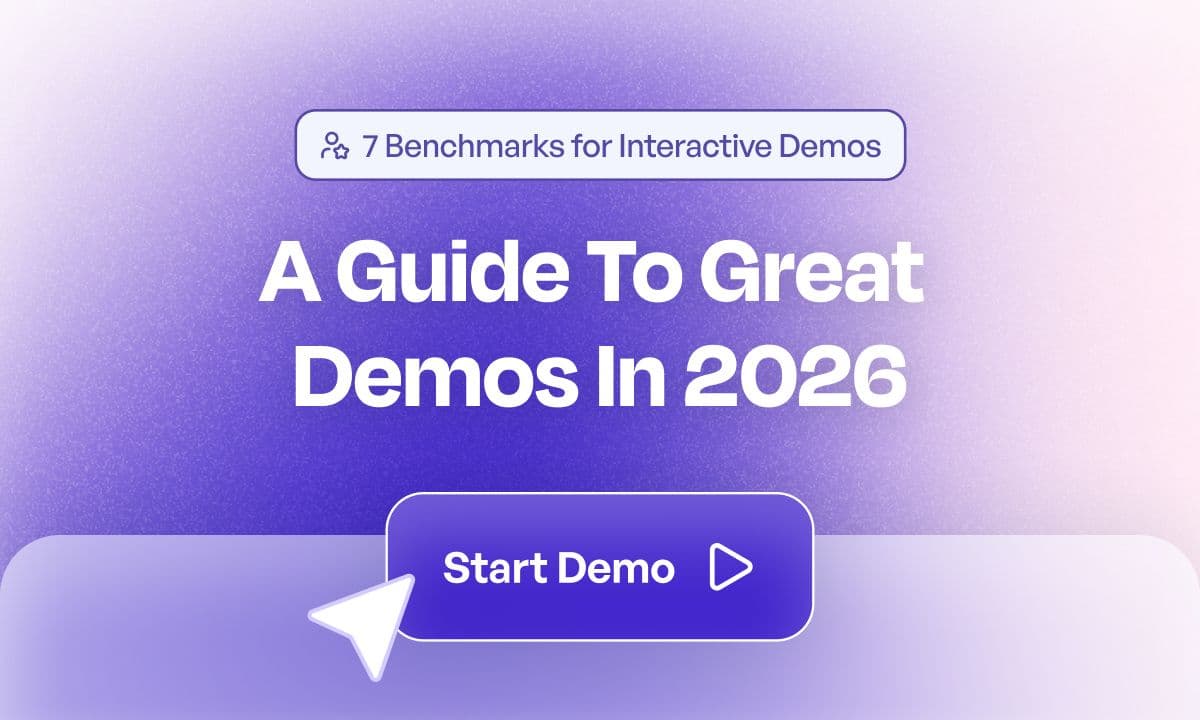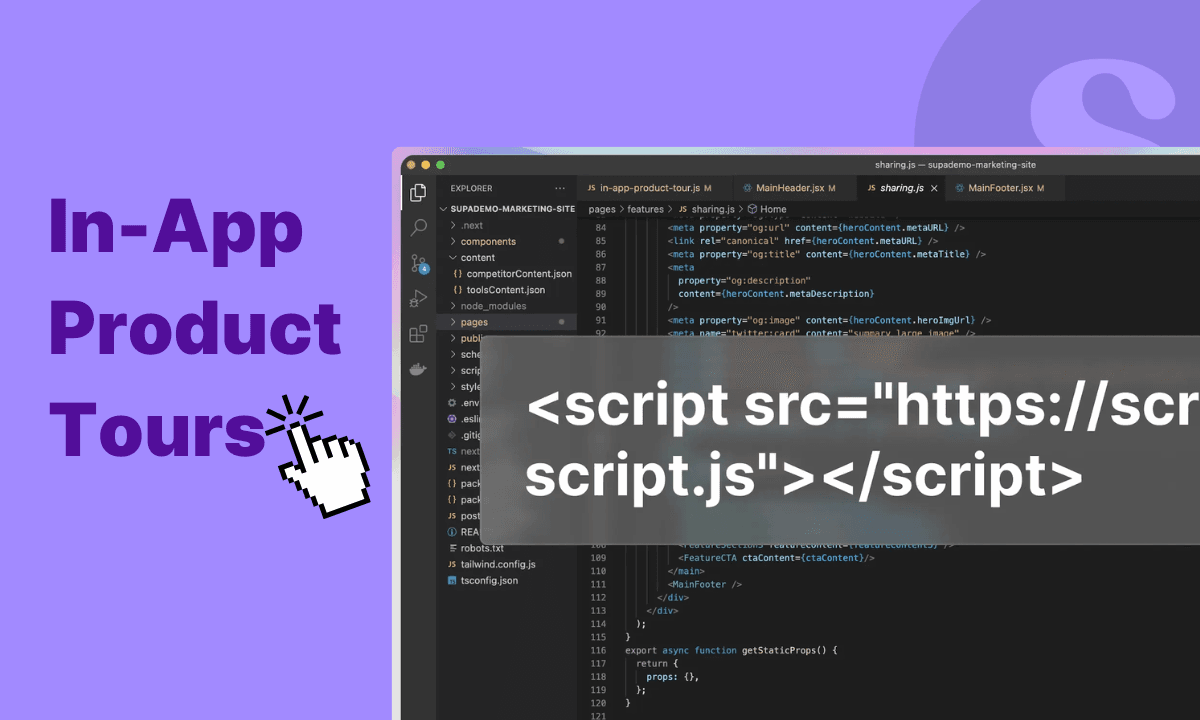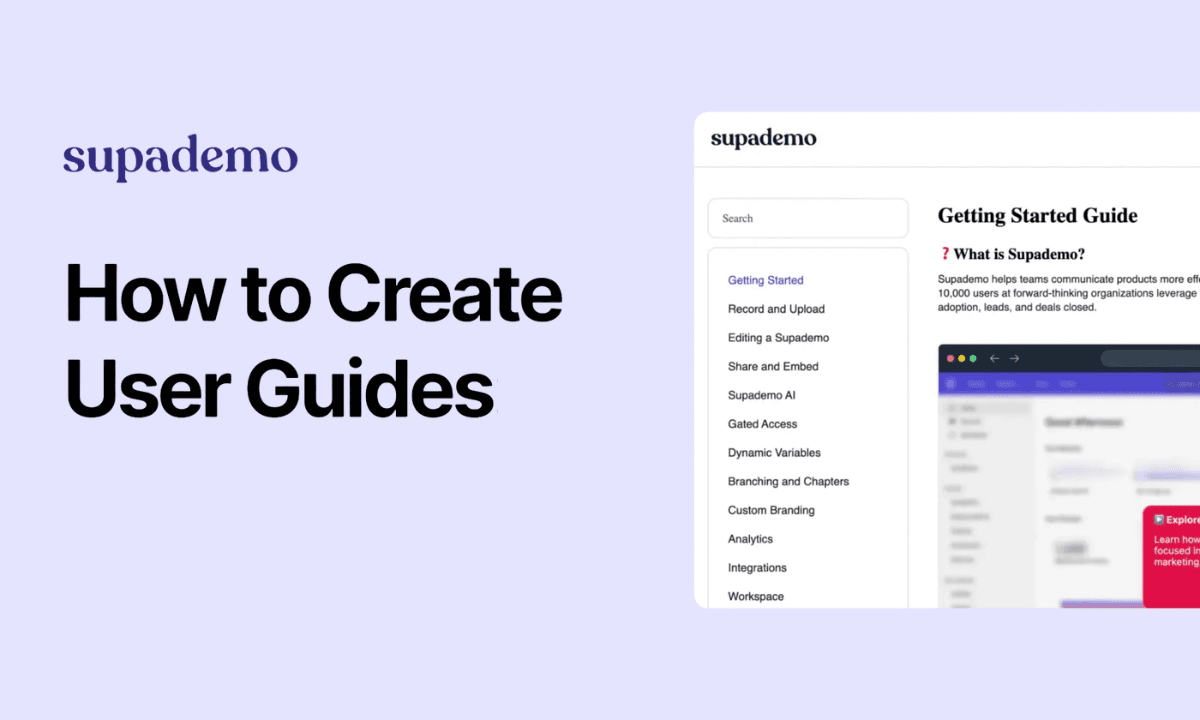What is a Product Demonstration - Types, Benefits, Tips
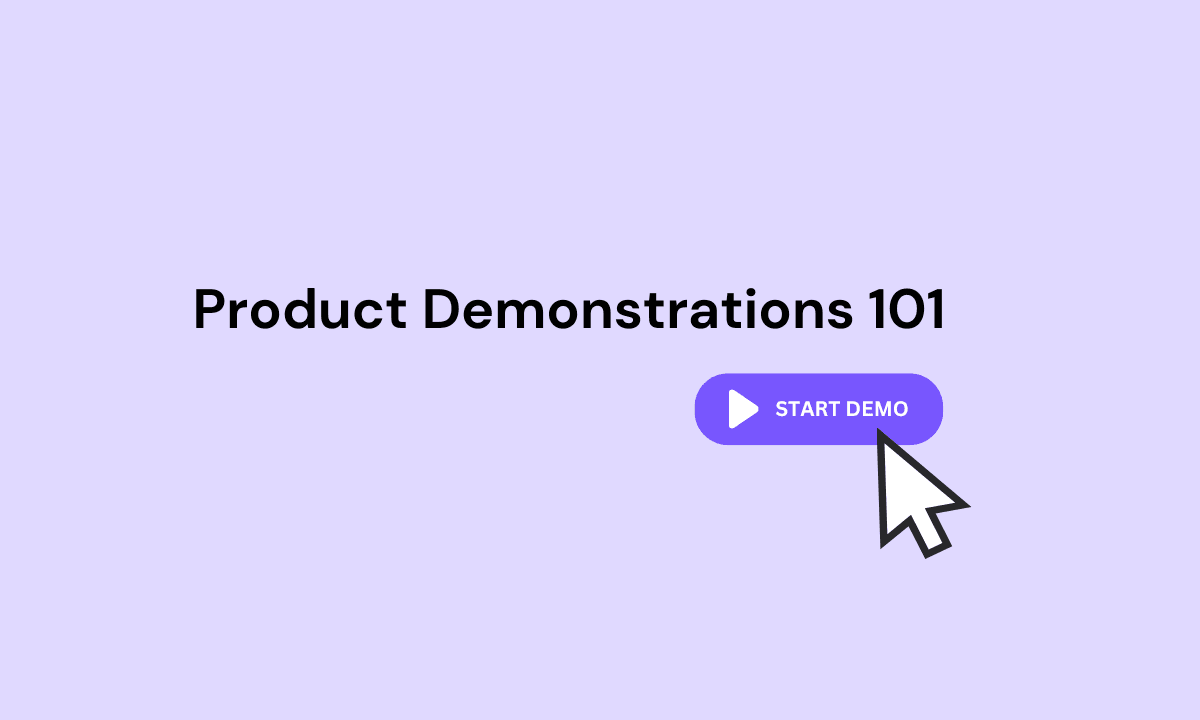
Product demonstrations are the heartbeat of SaaS sales. They bridge the gap between product features and customer needs, turning curiosity into conviction.
Whether you're a startup or an established player, mastering the art of product demos can significantly boost your conversion rates and accelerate growth.
This guide will walk you through everything you need to know about crafting compelling product demonstrations that resonate with your audience and drive results.
What is a Product Demonstration?

A product demonstration is a focused software demo presentation that showcases a product's key features, benefits, and applications. It's a vital tool in sales and marketing, designed to:
- Highlight the product's value
- Illustrate its practical uses
- Address potential customer needs
Product demos can take various forms:
- Live presentations
- Interactive product demos
- Pre-recorded videos
- Webinars
The primary goal is to give potential customers a clear understanding of how the product works and why it's worth their investment. Whether it's software, hardware, or a service, a well-executed demo can significantly influence purchasing decisions.
Modern, effective product demonstrations go beyond mere descriptions. They provide hands-on experiences or visual representations that allow the audience to envision how the product could solve their specific problems or improve their processes.
👆🏼
Read more:
Ultimate Guide to Software Demo Presentations (2025)
Benefits of Conducting Product Demonstrations

Let's take a detailed look at the benefits of product demonstrations and why you should focus on creating the perfect product demos:
1. Accelerates sales processes
Product demonstrations serve as a powerful catalyst in the sales process, significantly accelerating the journey from initial interest to final purchase.
By providing potential customers with a hands-on experience, demos offer a clear and concise understanding of the product's value proposition.
This direct interaction allows customers to quickly grasp how the product addresses their specific needs, leading to faster decision-making. As a result, the sales cycle is streamlined, potentially boosting overall sales figures and improving the efficiency of the entire sales funnel.
2. Proves product effectiveness
The importance of product demos for SaaS companies [lies in] building a strong market. SaaS companies create new markets, addressing a need no one had thought of before. But [first], they have to persuade people to solve an outdated issue with a new approach. With a product demo, you can clearly explain why your innovation boosts the status quo and encourage potential buyers to adopt new behaviors.
- Stella Cooper, CEO at PaydayLoansUK.
One of the most compelling aspects of product demonstrations is their ability to prove a product's effectiveness in real time. Unlike marketing materials or sales pitches, demos provide tangible evidence of a product's capabilities and performance. This firsthand experience builds customer confidence in both the product and the brand behind it.
By showcasing how the product solves real-world problems or enhances existing processes, demonstrations move beyond mere claims, offering concrete proof of value. This visual and interactive validation can be particularly powerful in industries where reliability and performance are crucial factors in purchasing decisions.
3. Gathers direct feedback
A product demo also allows you to learn more about your target market. Requesting a product demonstration is a strong buying signal. Therefore, those who take the time to listen to a product demo reflect the characteristics of your ideal customers. Demos enable you to understand their needs and difficulties better. You can then use this learning to aid you in converting more sales in the future.
- Sean O’Neal, President at Onclusive.
Product demonstrations also offer an invaluable opportunity for direct customer feedback. During a demo, potential buyers can ask questions, raise concerns, and provide immediate reactions to the product's features and functionality.
This real-time interaction creates a goldmine of insights for product development teams. By identifying common pain points, areas of interest, or potential improvements, companies can refine their offerings to better meet market demands. Moreover, this two-way communication fosters stronger relationships with customers, showing that the company values their input and is committed to meeting their needs.
4. Creates a sense of ownership
A well-executed product demonstration can create a powerful sense of ownership among potential customers. By allowing users to interact with the product in a meaningful way, demos serve as a risk-free trial experience. This hands-on approach helps customers envision how the product would fit into their own workflows or solve their specific challenges.
As customers engage with the product, they become more invested in its potential benefits, which can significantly reduce perceived risks associated with the purchase. This psychological ownership can be a key factor in overcoming objections and nudging customers toward a positive buying decision.
5. Reinforces brand identity
Beyond showcasing the product itself, product demonstrations provide an excellent platform for reinforcing brand identity. The style, language, and overall presentation of a demo can be tailored to reflect the company's unique personality and values. This cohesive brand experience helps create a lasting impression on potential customers, improving brand recall and differentiation in a crowded marketplace.
By aligning the demo with the company's broader mission and ethos, businesses can create a more emotional connection with their audience, moving beyond feature comparisons to establish a deeper brand relationship.
6. Addresses specific customer needs
During the product demo, you will have the opportunity to listen to the customer’s specific requirements and demonstrate how your product will meet these needs and make their jobs easier. Being able to show how your product can assist them can significantly impact their purchasing decision.
- Sean O’Neal, President at Onclusive.
One of the key strengths of product demonstrations is their adaptability to specific customer needs. Unlike generic marketing materials, demos can be customized to address the unique requirements of different industries, company sizes, or use cases. This tailored approach ensures that the demonstration remains relevant and engaging for each audience.
In fact, 40% of buyers prefer personalized product demonstrations to make software purchase decisions.
By highlighting features and benefits that directly align with a customer's pain points, demos can clearly illustrate how the product fits into existing workflows or integrates with current systems. This level of customization not only improves the effectiveness of the presentation but also shows potential customers that the company understands and values their specific needs.
The Impact of Product Demonstrations on Conversion Rates
Product demonstrations play a crucial role in the success of SaaS businesses. A well-crafted demo can significantly boost your sales team's performance and directly impact your bottom line.
Consider this scenario:
An average SaaS company might conduct 6-10 demos per week. Let's say their product has an annual contract value of $25,000. If their demo-to-sale conversion rate is on the lower end at 25%, they could be generating around $2 million in annual sales. However, if they improve their conversion rate to 40%, that same number of demos could result in $3.2 million in annual sales.
This example illustrates the potential impact of effective product demonstrations. By improving your demo strategy, you could potentially increase your revenue by over $1 million annually without increasing the number of demos conducted.
Factors that can influence demo effectiveness include:
- Tailoring the demo to the specific needs of each prospect
- Clearly highlighting the product's value proposition
- Addressing common pain points
- Providing an engaging and interactive experience
Remember, a great product demonstration isn't just about showcasing features. It's about demonstrating how your solution can solve real problems for your potential customers.
By focusing on creating impactful demos, you can significantly improve your conversion rates, boost your sales, and drive the growth of your SaaS business.
Types of Product Demonstrations in SaaS
Now, let's dive right into the different types of SaaS demos you can create to delight your prospects and convert them effortlessly.
1. Product Demo Videos
Product demo videos are visual tools that showcase a SaaS product's functionality and key features. These videos play a crucial role in customer acquisition by educating potential clients about the product's capabilities and benefits.
Effective product demo videos typically:
- Run 2-5 minutes long
- Focus on core functionalities
- Use high-quality visuals and clear narration
- Demonstrate problem-solving capabilities
- Can be customized for different audiences
Common uses include:
- Website and product pages
- Landing pages
- Social media and email marketing
- Paid advertising
Pro tip
shows businesses that source over 40% of their leads from marketing experience higher conversion rates than others. So, use your best product demos in marketing collaterals to get the best results.
The main goals are to:
- Capture viewer attention
- Highlight unique selling points
- Provide a clear call-to-action (e.g., sign up for a trial, schedule a demo)
By offering a visual explanation of the product, these videos can effectively communicate value, build trust, and move prospects through the sales funnel.
Here's an example of a great product demo video by Linear -
2. Live Product Demos from a Sales Team
Live product demonstrations offer a personalized approach to showcasing SaaS solutions. Conducted by sales representatives, these demos provide direct interaction with potential customers.
Key features:
- Real-time presentation of product functionality
- Tailored to specific customer needs and questions
- Can be delivered in-person or via video conferencing
- Suitable for both one-on-one sessions and group webinars
Benefits:
- Highly engaging and interactive
- Allows for immediate addressing of customer concerns
- Demonstrates how the product solves specific customer problems
- Provides opportunity for relationship-building
Live demos are particularly effective for:
- Complex products requiring detailed explanation
- High-value deals needing personalized attention
- Generating qualified leads
- Moving prospects closer to purchase decisions
By offering a personalized experience, live demos help sales teams showcase product value, build trust, and close deals more effectively. They allow for dynamic presentations that can adapt in real-time to customer interests and questions.

3. Interactive Demo
🧐
say that detailed product descriptions or interactive SaaS demos help them make better purchasing decisions.
Interactive product demos offer potential customers an immersive, hands-on experience of the product during the entire buying and enablement journey — including discovery, purchase, and adoption.
Typically guided by pre-programmed steps, an interactive product demonstration guides users through key features or persona-based benefits for your product – helping visually guide viewers in a step-by-step, engaging way. Best of all, viewers don't need to download or have access to your tool (or be a customer) to learn about these features. No paywall, no subscription, no endless discovery calls before getting hands-on with the product.
Key features:
- Pre-programmed, step-by-step guidance
- Highlight key features and persona-based benefits
- Accessible without product installation or user accounts
- Customizable for different user journeys
Benefits:
- Engages users actively in the discovery process
- Accelerates the buying decision
- Reduces friction in the sales process
- Allows prospects to experience the product firsthand
Applications:
- Pre-sales exploration
- Self-service product discovery
- Customer onboarding
- Feature adoption
Here’s an example of an interactive product demo which guides you through the features of Lemlist.
Interactive demos bridge the gap between marketing materials and the actual product experience. They empower potential customers to explore the product at their own pace, fostering a deeper understanding and connection with the solution.
Which Type of Product Demonstration Should You Use?
Choosing the right product demo depends on your SaaS business model and product characteristics. Several factors influence this decision, with your growth strategy being a key consideration.
Sales-led vs. Product-led Growth

For product-led growth companies, the product itself is the main marketing tool. These businesses often prefer interactive in-app demos. This approach allows potential customers to engage directly with the product, experiencing its value firsthand. Interactive demos can effectively showcase the product's features and benefits without requiring a full commitment from the user.
On the other hand, sales-led companies typically benefit more from sales demo videos. These videos are designed to optimize the sales process by presenting the product's key features and benefits in an engaging, visual format. They can be easily shared with potential customers and used to support sales conversations, making them an ideal tool for businesses that rely on a more traditional sales approach.
However, the choice isn't always black and white. Many successful SaaS companies use a mix of demo types to cater to different stages of the customer journey and various customer preferences. The key is to understand your target audience and choose the demo type that best addresses their needs and concerns.
Consider factors like your product's complexity, your target market's preferences, and your sales cycle length when deciding on the most effective demo type. Remember, the goal is to provide potential customers with the information they need in the most engaging and accessible way possible.
High-touch vs. Low-touch Onboarding
Your onboarding approach affects which type of product demo works best for your SaaS business.

Low-touch Onboarding
Low-touch onboarding is all about self-service. It's for customers who like to learn on their own. This approach uses:
These tools let users set up and use the product by themselves. Low-touch works well for simple products or tech-savvy users who don't need much help.
High-touch Onboarding
High-touch onboarding offers personal help. It's used for:
- Complex products
- Enterprise customers
- High-paying clients
This approach often includes:
- Live demos by sales reps
- One-on-one training
- Custom setup plans
High-touch makes sure important customers get all the help they need.
Your choice depends on what you're selling and who's buying. Some businesses use both approaches, offering different levels of help based on customer needs or what they're paying.
The main goal is to help customers start using your product successfully. Pick the approach that best fits your product and customers.
The Complexity of Your Product
B2B SaaS companies rely on their sales model to drive growth, with three main options: self-serve, enterprise, and transactional. The choice depends on Average Revenue Per User (ARPU) and Customer Acquisition Cost (CAC).
It's crucial for sales and marketing teams to align on this model to avoid wasted resources, inconsistent messaging, and missed opportunities. By ensuring everyone understands and operates within the right model for your product and market, you can create a focused and effective growth strategy.

And...how complex your product is plays a big role in choosing the right demo type.
Complex products take longer to learn and need more guidance. For these, live demos might seem good at first, as you can answer questions directly. But they can take too much time and be hard for clients to remember everything.
A better approach for complex products is:
- Creating multiple product demo videos.
- Adding these videos to an online resource center.
This way, users can:
- Find the exact help they need, when they need it.
- Watch videos as many times as they want.
- Learn at their own pace.
Simpler products might do well with:
- Interactive demos
- Short overview videos
- Quick-start guides
The goal is to match your demo style to how much help users need to understand your product.
Remember, the right product demonstration makes it easier for customers to learn and use your product successfully. Furthermore, according to Salesforce, 45% of end users prefer short and easy-to-understand demos.
How to Create an Effective Product Demo?
Crafting a successful product demo requires careful planning and execution. Here's how to approach it:
Match Demo Types to the Buyer's Journey

Different stages of the buyer's journey call for different types of demos. Here's a breakdown:
Awareness Stage:
• Use short, engaging demo videos
• Introduce your product and its key benefits quickly
• Focus on grabbing attention and sparking interest
Consideration Stage:
• Offer more in-depth demonstrations
• Consider webinars or interactive demos
• Show how your product solves specific problems
• Allow for comparison with alternatives
Decision Stage:
• Provide
• Use live demonstrations or tailored recorded demos
• Focus on specific customer goals and use cases
• Include relevant case studies or success stories
Remember, the goal is to guide potential customers through the sales funnel. Each demo should be designed to move them to the next stage of their decision-making process.
Pro tip:
Providing user testimonials within the product demo can increase conversions by as much as
.
By aligning your demo type with the buyer's journey, you can:
- Address the right questions at the right time
- Provide relevant information as needed
- Increase engagement and interest
- Improve conversion rates at each stage
Using the Right Tools for Your Product Demo
Once you've decided on the type of demo, it's time to create it. Choosing the right tool is crucial for producing an effective demo. Here are some of our suggestions to help you get started.
For Pre-recorded Demos:
Consider tools like Loom or Screen Studio for simple screen recordings. For more advanced editing, look into software like Camtasia.
For Live Demos:
Popular options include Zoom, Google Meet, or Vimeo for live streaming. Choose based on your needs for interactivity and audience size. To reach a wider audience, you can use tools that allow you to stream to multiple platforms, ensuring your demo is accessible to viewers on different channels simultaneously.
Supademo is an excellent choice for creating engaging, interactive product tours. It allows you to create guided walkthroughs of your product without coding.
Interactive Demos are Redefining Product Demonstrations As We Know It Across Teams
B2B buying has changed. It's no longer a linear journey where you can get the buyer on a discovery call, book a demo walkthrough, and seal the deal.
Today's buyers demand more than that:
- They want to play around the product before they make a case to get buy-in;
- They want to realize the product's value before they pay for it;
- They want to be confident in their purchase;
To meet this demand for more information up-front, you can no longer depend solely on jargon or static images that lack fidelity or context for the user. While these landing pages yield some basic results, they fall short when it comes to visually demonstrating your product's features or benefits in a captivating way.
And that's where interactive demo software like Supademo can help.
Whether you work in marketing, sales, or customer success, interactive product demos have some amazing benefits to offer. Key highlights include shortening sales cycles, increasing prospect conversions, efficiency gains, and faster product adoption.
While there are hundreds of benefits depending on the use case, here’s a quick visual overview of some of the main benefits:

👆🏼
Read more about interactive product demos, their benefits, and how to create one in < 5 mins here -
Interactive Product Demo 101: A Comprehensive Guide
Get Started with Your First Interactive Product Demonstration
In conclusion, interactive demos help you break down barriers between your product and your buyers and users. By empowering them with the power to discover, adopt, and educate at their own pace, you can build trust, reduce skepticism, and boost engagement.
And, with Supademo, anyone can create beautifully interactive product demos in just a few minutes – for free with no technical expertise required.
Even better, you get more than just recording or creating a demo with Supademo. There are countless features to help trigger and accelerate the Aha! moment for your buyers. So, head over to Supademo to start creating an engaging, interactive demo – it's free!

Hiba Fathima
Hiba Fathima is the first Product Marketer at Supademo. She previously led product marketing at top Indian tech firms and loves turning complex products into clear, compelling stories.
